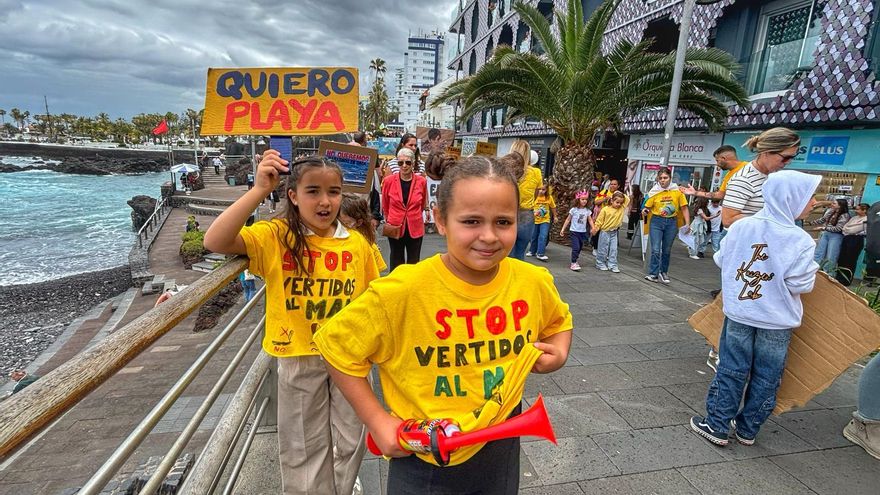The port of La Cruz is not only unusual for being a port without a port – The municipality carries decades of unfulfilled commitments and a series of planning failures, which at this juncture leaves younger locals doubtful about witnessing the anticipated maritime infrastructure intended to rejuvenate the northern region – but it is also distinctive for hosting a beach that is no longer a beach.
For more than eight months, the area known as Poor Garden Beach Water Quality –Today is the term given to the entire stretch that includes Playa Chica, adjacent to the tip of La Salema, Punta Brava, Galán, and extending beyond the castle beach – has necessitated the closure of the main bathing zone of the tourist city.
The polluted discharges have deprived the Portuenses of one of their premier recreational spots – especially now that spring has arrived and temperatures are beginning to rise – compromised the destination’s reputation, undermined the management of institutions and, predictably, led the locals to exasperation. It is hardly surprising that over 2,000 individuals took to the streets this Sunday, participating in a lively procession from the beach of Martiánez, at one end of the municipality, to the neighbourhood of Punta Brava, at the opposite end, in protest against an environmental crisis that has exposed the inadequacies of public administration. Notably, an official report from the Aguas Insular Council, an establishment under the Cabildo de Tenerife, had already issued warnings in 2022 regarding the polluting discharges that two and a half years later – in July 2024 – resulted in the closure of Playa Jardín.

«I want to swim in Playa Jardín». «Tenerife pains us and we stand up for it ». “The locals are not to blame.” “The sea is life, not a dump.” These are just a few of the numerous placards that adorned the demonstration. Among the tourists, some attended the massive protest looking incredulous, while others were empathetic towards the demonstrators. The former were newcomers, many of whom were unaware that they wouldn’t be able to swim in Playa Jardín this year – as most visitors to the port of La Cruz are repeat tourists – while the latter, who made up the majority of the protest, had been enjoying their favourite destination for days or even weeks without the opportunity to swim on the black sand beach. “It’s a complete mess, a genuine disaster … They’ve known about this for years, the council, the municipality, the government …, all of them, the waste being dumped into the sea, and nobody did anything,” remarked Conchi, a resident of Punta Brava – the neighbourhood to the west of the Garden beach, with the castle of San Felipe to the east – while the crowd thronged in the centre of the city, where bars and cafes had to remove tables due to an influx that exceeded expectations.
In fact, not only locals, associations, and civic groups from La Cruz were present at the demonstration, but also contingents from other areas of Tenerife, such as those advocating for the protection of Tejita, which is named after the beach in El Médano. The protest transcended local boundaries, creating a movement to defend the protection of the island’s coast. Within La Cruz itself, environmental issues linked to wastewater discharges are not limited to Playa Jardín; pollution levels have nearly exceeded acceptable limits on San Telmo beach, located along the promenade of the same name, as well as around the pools of Lake Martiánez, as revealed by a study from the specialised firm Elitoral, which highlighted the “discovery of fecal contamination at point MM8, situated in an area influenced by the San Telmo pumping station discharge and the vicinity of the Lake Martiánez tourist complex.”
“Summer is approaching and we won’t be able to swim, you’ll see,” mentioned another resident living in one of the newer blocks on Mequinez Street, who described how her routine since retiring with her husband involves walking to the beach of the castle – the easternmost part of the overall Garden beach – and enjoying a swim before lunch. “I don’t fancy swimming by the dock, and if I can’t go to Martiánez, I’ll just stay home,” she said. Nevertheless, the City Council has been adamant that Playa Jardín will be open again by summer.
Multiple Shortcomings
Stop poured into the sea is the citizens’ platform that organised the demonstration which took place through the streets of Puerto de la Cruz in protest against the polluting spills affecting the coast of the tourist town.
Playa Jardín was closed to swimming in July 2024 after identifying levels of fecal contamination in its waters that posed health risks to bathers. The treatment facility, the emissary, the sanitation network, and three overflow points constitute the various sources of wastewater. The failures highlighted by an investigation from the specialised firm Elitoral are numerous.
However, the worst aspect is that Elitoral’s findings were not unexpected, as the situation was already known since 2022, with a report from the Aguas Insular Council warning of the serious issues arising from the pollutant sources impacting Playa Jardín.
















